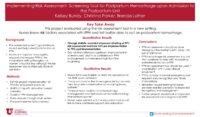The Graduate Nursing Project collection includes Doctor of Nursing Practice (DNP) Scholarly Projects and Master's students' non-thesis projects submitted as part of program requirements.
TO
- Graduate Nursing Project, Doctor of Nursing Practice, DNP5
- Graduate Nursing Project, Doctor of Nursing Practice, DNP, Women's Health / Nurse Midwifery, Poster3
- Graduate Nursing Project, Doctor of Nursing Practice, DNP, Nurse Midwifery / Women's Health1
- Graduate Nursing Project, Doctor of Nursing Practice, DNP, Nurse Midwifery / Women's Health, Poster1
1 - 25 of 10
| Title | Creator | Date | Description | Relation Is Part Of | ||
|---|---|---|---|---|---|---|
| 1 |
 |
Implementing Risk Assessment Screening Tool for Postpartum Hemorrhage upon Admission to the Postpartum Unit | Bundy, Kelsey L. | 2023 | Background: Postpartum hemorrhage (PPH) continues to remain the leading cause of maternal mortality and morbidity, with increasing numbers in the United States accounting for 11% of pregnancy related deaths (Watkins and Stem, 2020). Obstetric hemorrhage risk assessment screening should be performed ... | Graduate Nursing Project, Doctor of Nursing Practice, DNP, Nurse Midwifery / Women's Health |
| 2 |
 |
Implementing Risk Assessment Screening Tool for Postpartum Hemorrhage upon Admission to the Postpartum Unit | Bundy, Kelsey | 2023 | POSTER | Graduate Nursing Project, Doctor of Nursing Practice, DNP, Nurse Midwifery / Women's Health, Poster |
| 3 |
 |
Reducing Continuous Urinary Catheter Use in Postpartum Women | Merrill, Eric; Phares, Pamela | 2021 | POSTER | Graduate Nursing Project, Doctor of Nursing Practice, DNP, Women's Health / Nurse Midwifery, Poster |
| 4 |
 |
Reducing the Duration of Peripheral Intravenous Catheter Dwell Time in Women at Low-Risk for Postpartum Hemorrhage | Morris, Nathan M.; Phares, Pamela | 2021 | POSTER | Graduate Nursing Project, Doctor of Nursing Practice, DNP, Women's Health / Nurse Midwifery, Poster |
| 5 |
 |
Improving Postpartum Hemorrhage Management in a Rural Setting Through Simulation-Based Training | DuBois, Jackie | 2019 | POSTER | Graduate Nursing Project, Doctor of Nursing Practice, DNP, Women's Health / Nurse Midwifery, Poster |
| 6 |
 |
The Effects of a Postpartum Hemorrhage Checklist on Provider Self-Efficacy | Crowther, Shawn | 2019 | The United States has seen an increase in postpartum hemorrhage (PPH) rates in recent years from 2.3% (n = 85,954) to 2.9% (n = 124,708). In an effort to reduce the incidence of PPH, checklists are being used with increased frequency in many hospitals in the United States and worldwide. The purpose ... | Graduate Nursing Project, Doctor of Nursing Practice, DNP |
| 7 |
 |
Improving Postpartum Hemorrhage Management in a Rural Setting | DuBois, Jackie | 2019 | The leading cause of maternal death worldwide is postpartum hemorrhage, followed by hypertensive disorders, infection, complications with delivery, and unsafe abortions. Globally, hundreds of women die every day in childbirth due to these causes, and in 2015, there were 45,000 maternal deaths in Ind... | Graduate Nursing Project, Doctor of Nursing Practice, DNP |
| 8 |
 |
Simulation Training for Blood Loss Recognition During Waterbirth | Lazzara, Jennifer | 2016 | The occurrance of waterbirth (WB) in labor and delivery (L&D) units across the U.S. is a new mode of delivery for many delivering providers. As a result, providers lack experience in evaluating blood loss in water. Proper training and tools to accurately identify blood loss in water are needed for t... | Graduate Nursing Project, Doctor of Nursing Practice, DNP |
| 9 |
 |
Postpartum Hemorrhage Simulation Training | Powell, Justine Y. | 2016 | Postpartum hemorrhage (PPH) is the leading cause of death among women during childbirth, according to the Centers for Disease Control and Prevention (CDC) (2014). The World Health Organization (WHO) defines postpartum hemorrhage as a blood loss of 500 ml or more in the first 24 hours after birth, du... | Graduate Nursing Project, Doctor of Nursing Practice, DNP |
| 10 |
 |
Quality Improvement in Maternity Care: PPH Safety Bundles | Kimberly, Megan | 2016 | This project was designed to create the curriculum for disseminating the new post-partum hemorrhage (PPH) safety bundle to hospitals across the State of Utah. A bundle is a set of actions that when performed collectively have demonstrated to improve patient outcomes. The Council on Patient Safety in... | Graduate Nursing Project, Doctor of Nursing Practice, DNP |
1 - 25 of 10
